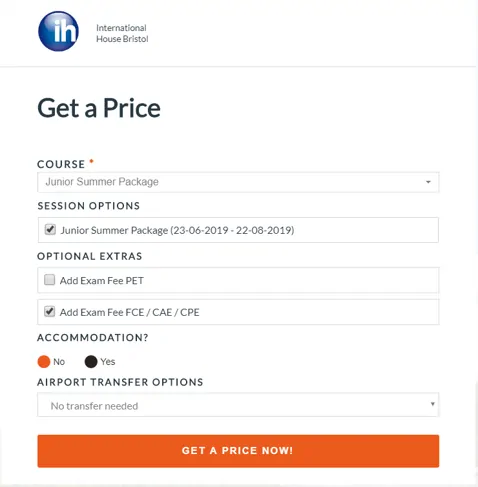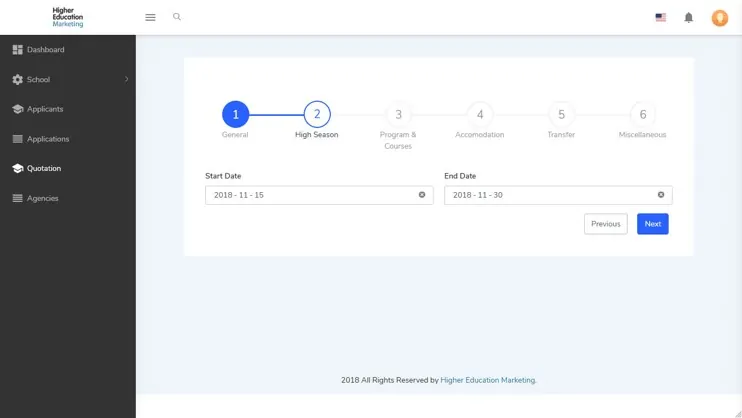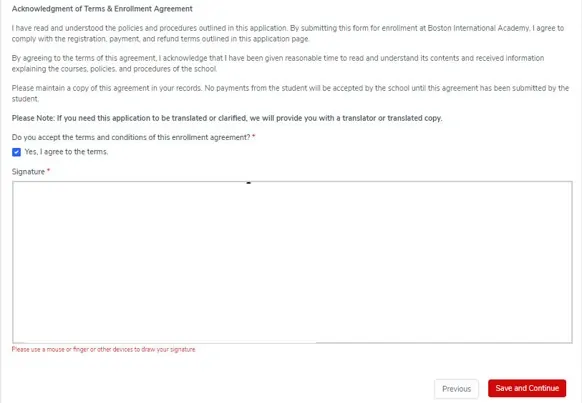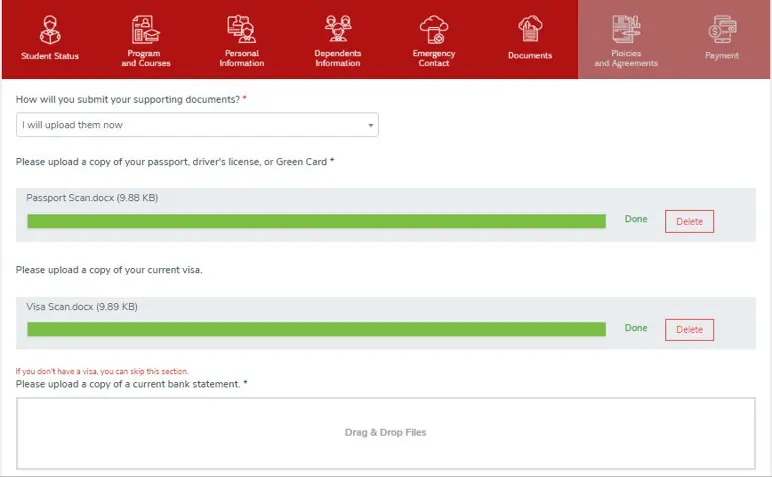
Could your school’s online application process be more convenient? Do your forms factor in every aspect of enrolling at your school, including accommodation, exam fees, or other optional extras? Can prospects take care of every aspect of their application online, or do they need to complete certain things by post or in-person?
The ease at which prospective students can navigate your application process can often make a lot of difference. A smooth, intuitive system eliminates any potential problems or confusion that could lead them to fail to submit, while also creating a positive impression of your institution.
If your current application process has proved problematic in the past, here are a few things that you could consider doing to improve it.

1. Allow Students to Create Unique Accounts When Applying to Your School
How often have you started filling out a complex form online, only to be interrupted? Or come across something halfway through that made you want more time to consider your decision? Or gotten almost all the way to the end of a form, only to find out you are missing a key piece of information or documentation?
This kind of thing happens all the time, particularly when it comes to school applications, which can be quite long and detailed. As a result, many institutions who track their online application completions will often see high numbers of users abandoning the process before they finish.
Using a system which allows them to create unique accounts and save their progress as they go along can help to mitigate this risk, while also saving prospects the headache of starting their applications from scratch again.
Example: HEM’s Application Portal requires students to create unique accounts.

Users can then save their application progress as they complete it.

2. Make it Possible to Create and Manage Multiple Applications
Account-based online application portals for schools can also be especially useful if you deal with education agents. Agents will often make applications on behalf of multiple students, and may even need to do so across different schools and campuses.
Allowing agents to create accounts enables them to manage all of their dealings with your school in one place. They can check the status of different applications, track any payments they may have made to your school, and save their progress on incomplete forms to better manage their workload. You can even enable agencies to create accounts with more than one agent, and still manage all of their applicants centrally.
This kind of functionality can also be put to use for parents, who may want to apply on behalf of more than one of their children, as well as employers if you are running professional development courses. By eliminating the need for these users to create account after account, you are making things a lot easier for some of your most valuable long-term target personas.
3. Include Accommodation and Other Extras in Your School’s Application Forms
If you are dealing with international students, or even just domestic students who are not from your local area, it’s possible that you may also arrange or provide accommodation for them as part of your intake process.
Rather than making these arrangements separately, your school can create fields in your application forms for prospects to select the accommodations they will need. This means that they can potentially book and pay for both their course and their accommodation in one sitting.
Example: Centre of English Studies’ online application form, which is powered by Class Systems, allows students to book both their course and accommodation in the same form.

You can factor in any other extra services you provide, too, such as airport pick ups and drop offs. If your school offers any excursions or activities for your students, they can all be included and booked as part of the application as well. You might even ask them to specify any dietary requirements, medical conditions, or other special needs they may have so that you can be fully prepared for their arrival. Provided you use an online application portal with flexible form building tools and field options, you can include whatever you need.
Example: HEM’s Application Portal has a simplified form builder so that you can easily create and customize the fields you include.

4. Let Applicants Customize Their Course and Program Options
In addition to accommodation and other optional extras, your forms should also allow prospects to be as specific as possible about their preferred course and program choices. For instance, you might offer multiple start dates or class schedules, or multiple course durations. Making sure students can choose the option they want at the point of application can help to eliminate any complications later on.
Depending on the nature of your programs and courses, you may also want to factor in any customizable course options. For example, if you offer optional modules or electives in your courses, your applicants might appreciate being able to state their preferences at an early stage.
Example: This application form, designed for a language school, offers multiple course and schedule options, start dates, and session durations.

Similarly, if your course has any additional components that are booked separately – such as a TOEFL or IETLS exam for language school students – including these options in your course applications can make it easier for prospects, and may even increase the amount of applicants who choose to avail of them.
Again, using a system with robust form building and pricing capabilities will help to ensure you can create comprehensive, all-inclusive forms that cover everything a new student could possibly need.
5. Supplement Your School’s Applications with Online Quotes to Improve Transparency
In addition to including course details and optional extras in your application forms, it might also be a good idea to supplement them with a free quote calculator that allows prospects to price out the total cost of attending your school.
Many universities, colleges, and other institutions are often guilty of being unclear about their fees and the costs students need to account for during their studies, and this can lead to problems as prospects progress through the enrollment journey only to be surprised by additional expenses they had not accounted for.
Offering free quotes before they apply will allow them to view a breakdown of your course fees, accommodation and any other extras, and better ascertain how feasible pursuing their studies is for them.
Example: International House Bristol use CoursePricer to provide free quotes for potential applicants.

Be sure to include the prices of any additional costs they will need to factor in, such as airport transfers and exam fees, in order to provide a detailed breakdown of everything involved in booking a place at your institution. If your school adjusts prices for high season, or offers other kinds of variable rates for your courses like group discounts, be sure to build those calculations into your quote, so that they won’t be misled or confused about the price.
Example: The free quote tool in HEM’s Application Portal allows schools to build in automatic price adjustments for high season.

The complete quotes can then be either emailed directly to leads, or presented on a web page with a prompt to proceed to making an application.
6. Integrate Popular Payment Gateways into Your School’s Application Process
If you’re prospects are applying online, it’s a fairly reasonable bet that they would prefer to pay online if possible, too. However, many school’s application portals are unable to process payments, requiring applicants to be redirected elsewhere, or even make transactions physically.
Being able to integrate your application portal with an online payment gateway can make the process much simpler. Paying through a well-known gateway such as Stripe or PayPal can also be reassuring for prospects who may be worried about paying online.
Example: HEM’s Application Portal supports multiple payment gateways.

In addition, some payment gateways offer a range of beneficial features that can make the process more convenient for your school and its applicants. Flywire, for instance, offers tailored solutions for the education sector that include a range of specialized options, such as the ability to create automated payment plans for students. The service also allows international students to pay in their own currency, and secures wholesale exchange rates to negate any exposure to exchange rate fluctuations for both students and schools.
Integrating your payment processes within your application portal will also make it easier for your school to track payments from students, as they will be identified in your system as they come in, saving you having to trawl through your accounts to match payments to applicants.
7. Let Applicants Sign Online with E-signature Tools
Do your applications require signatures? Whether they have to agree to contractual terms or verify certain information, needing prospects to sign off on an application can be very awkward if you are trying to digitize your process. Some schools are forced to ask applicants to print off and sign a document and then re-upload it, or seek their signature out during a later meeting in order to fully complete their application.
Fortunately, e-signatures are becoming more and more common as a way to remedy this problem, and are now used by a variety of different organizations in various sectors.
E-signatures come in a few different formats, and can often involve asking a prospect to type their name along with some verifiable personal information (like part of a social security number). However, the most common format involves the user tracing their signature on the screen with a stylus, a mouse or their finger.
Example: HEM’s Application Portal includes an e-signature tool.

E-signatures are legally binding and acceptable in over 27 countries, including all member states of the EU, Canada, Australia, China, the United States, and Russia. Other countries which do not have official legislation in place will still often accept them as substitutes for physical signatures, too.
Adding this feature to your school’s online application forms can allow you to speed up your process, save on paper, and digitally store your signed agreements. While it’s only a small thing, it still adds up to a more intuitive, smooth experience for your applicants.
8. Enable Document Uploads for Applicants
Your applications will also possibly require some kind of supporting documents from students. This could include a copy of their passport or another form of ID, photos, grade or exam transcripts, or supporting letters of recommendation, among other things.
You can make it easier for applicants by allowing them to upload these files when they make their application, rather than asking them to physically mail them or bring them to your school in person. Uploading these files will also make it easier to track and store them, and help you save on paper.
Depending on the nature of what you are asking for, prospects may need to upload a number of different kinds of files, such PDFs, JPEGs, and Word documents, so you should be careful to ensure that your system supports each file type that you require.
Example: This application form asks applicants to upload a scanned copy of their passport and visa.

It’s possible that not all of these elements will apply to your school. You may not offer accommodation or other extras, for instance, and not really need to worry about including these details. Likewise, you may not need a facility for them to upload documents, or sign forms online.
Nonetheless, any improvements you can make to your forms could be well worth your while, and help to improve your conversion rate at the bottom of your funnel. Providing you have a system which offers plenty of customization options, you should be able to create the perfect forms for your institution’s unique needs.






